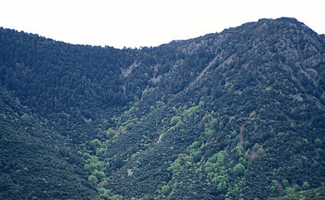Low winter temperatures determine the foliar morphology of Mediterranean plants

Leaf mass per area ratio (LMA) is a morphological parameter widely studied in plant physiology because of its importance in leaf functioning and in herbivory. LMA is very variable between the different plant species and also between individuals from the same species, because some environmental conditions have a strong influence on it. For example, a large number of studies have related high LMA with evergreeness, long leaf longevity, high solar irradiance, low nutrient availability and low water availability.
Summer drought is considered the most limiting factor for plant development in Mediterranean environments, and high LMA values in holm oak leaves are mainly associated with a protection to low water availability. Leaves with high LMA have a structure that reduces leaf photosynthetic rates but also water losses by transpiration.
In a large scale study of the Catalan holm oak forests conducted by CREAF, CSIC and UAB researchers, higher LMA values in holm oak leaves were observed in drier environments, but also in more sunny areas, and with lower air temperatures. The effect of solar irradiance and air temperatures was even greater than the effect of water availability, especially in the case of cold winter temperature which was the most important factor affecting LMA values in holm oak leaves.
These results indicate that high LMA values do not constitute a specific protection to dry conditions but to a wide range of environmental stress factors, including low temperatures.
References
"Leaf mass per area ratio in Quercus ilex leaves under a wide range of climatic conditions. The importance of low temperatures". Ogaya, R; Peñuelas, J. ACTA OECOLOGICA 31: 168-173. APR-2007.

